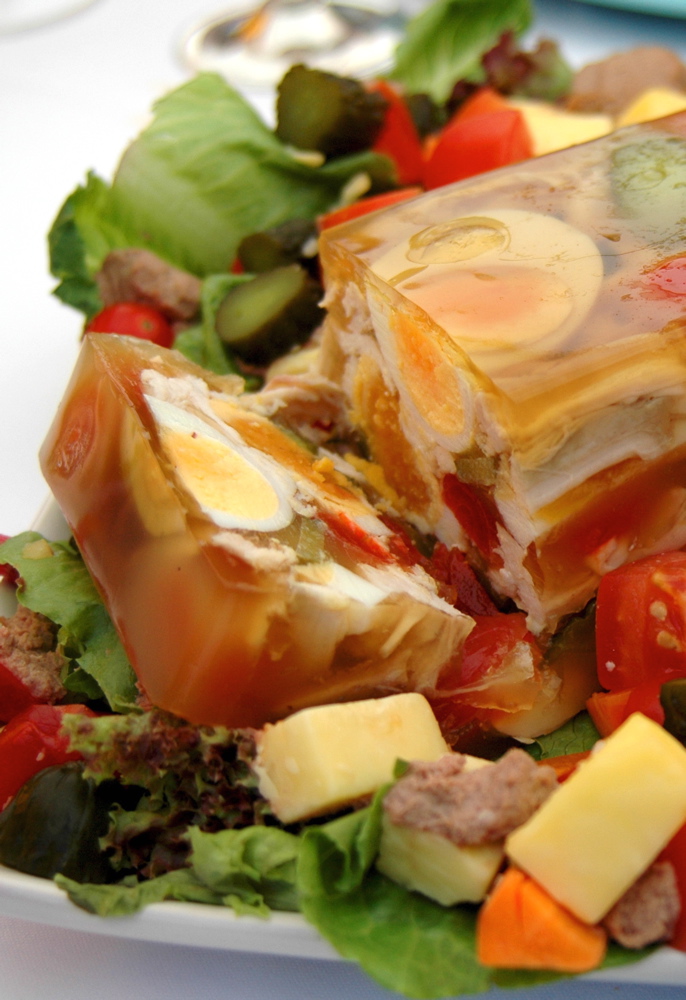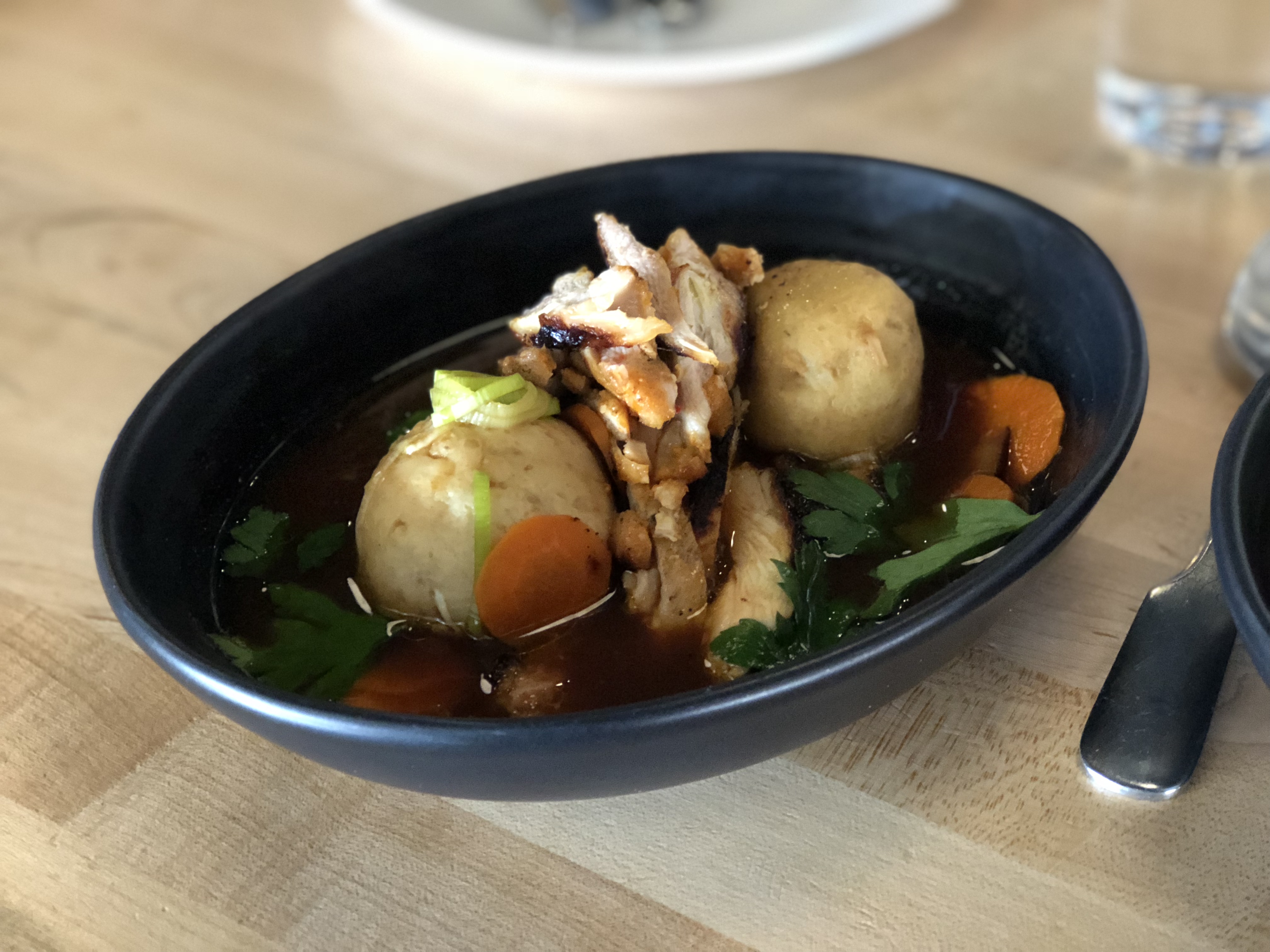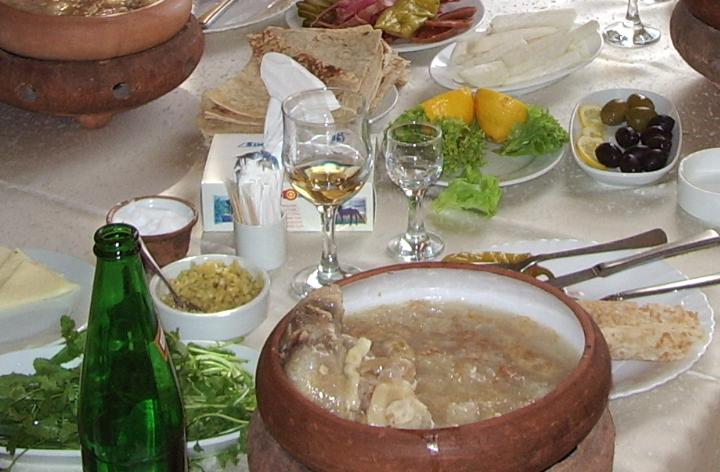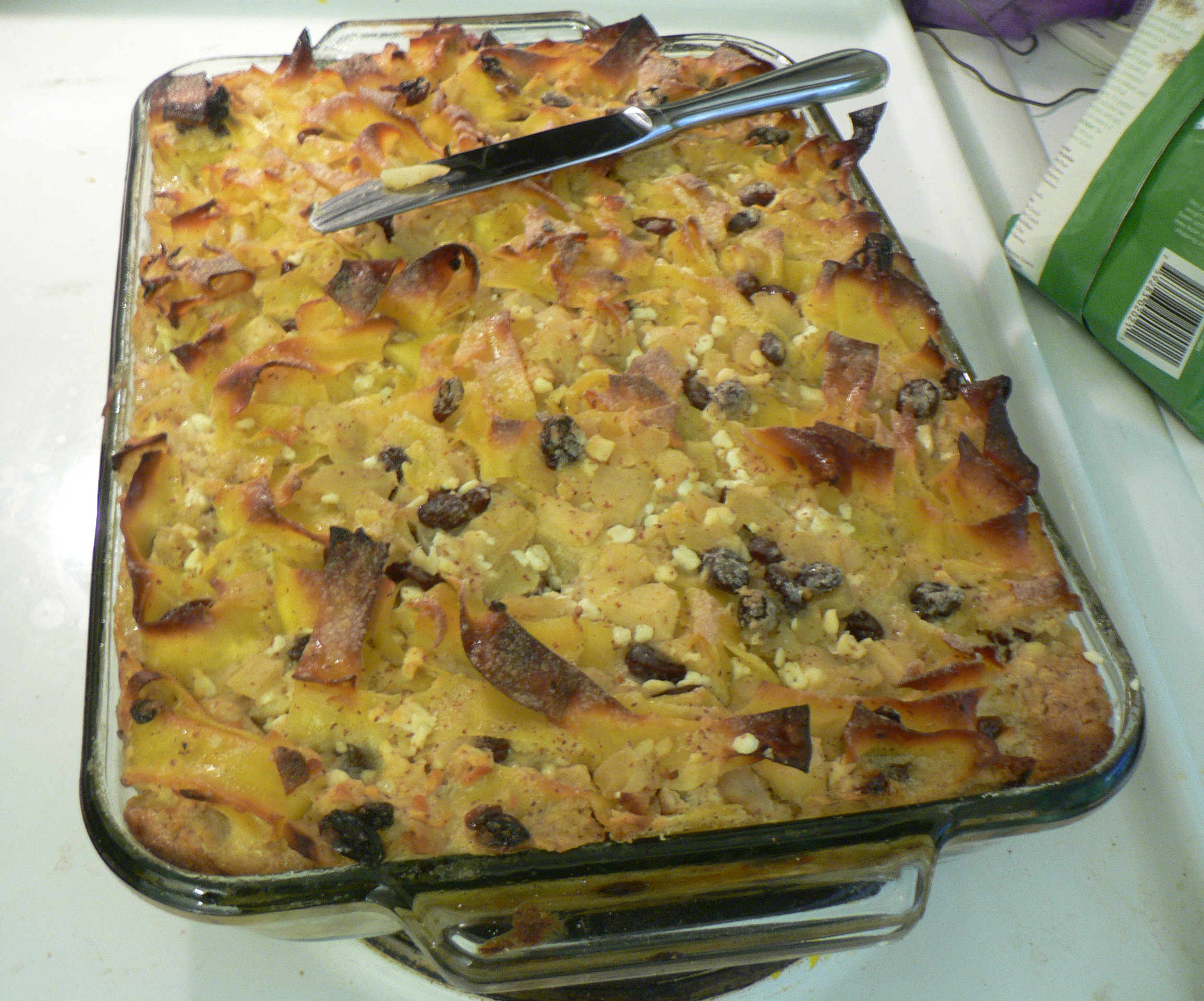|
P'tcha
P'tcha, fisnoga or galareta (also known as "calves' foot jelly") is a traditional Ashkenazi Jewish dish. It is a kind of aspic prepared from calves' feet. The name appears to derive from the Turkish words ''paça çorbası'', or "leg soup". History In Eastern Europe, Jews served p'tcha with chopped eggs on Sabbath. In the early 20th century, Jewish immigrants in the United States continued to prepare the dish, and it was often served as an appetizer at Jewish weddings. The ''Encyclopedia of Jewish Food'' describes it as a delicacy made from one of the least expensive parts of the animal. The Second Avenue Deli in Manhattan was one of the few Jewish restaurants in the United States that still served p'tcha, but does no longer. Given the small and dwindling customer base, p'tcha is made to order upon request. In 2019, a kosher deli opened in Miami that serves p'tcha. See also * Aspic (also known as ''studen'') * Head cheese * Kholodets (dish) * Pacha (dish) Khash ( hy, խաշ ... [...More Info...] [...Related Items...] OR: [Wikipedia] [Google] [Baidu] |
Jewish Cuisine
Jewish cuisine refers to the worldwide cooking traditions of the Jewish people. During its evolution over the course of many centuries, it has been shaped by Jewish dietary laws (''kashrut''), Jewish festivals and holidays, and traditions centred around Shabbat. Jewish cuisine is influenced by the economics, agriculture, and culinary traditions of the many countries where Jewish communities have settled and varies widely throughout the entire world. The history of Jewish cuisine begins with the cuisine of the ancient Israelites. As the Jewish diaspora grew, different styles of Jewish cooking developed. The distinctive styles in Jewish cuisine vary by each community across the Ashkenazi, Sephardi, and Mizrahi diaspora groupings; there are also notable dishes within the culinary traditions of the stand-alone significant Jewish diaspora communities from Greece, Iran, and Yemen. Since the establishment of the State of Israel in 1948, and particularly since the late 1970s, ... [...More Info...] [...Related Items...] OR: [Wikipedia] [Google] [Baidu] |
Aspic
Aspic or meat jelly () is a savory gelatin made with a meat stock or broth, set in a mold to encase other ingredients. These often include pieces of meat, seafood, vegetable, or eggs. Aspic is also sometimes referred to as ''aspic gelée'' or ''aspic jelly''. In its simplest form, aspic is essentially a gelatinous version of conventional soup. History The 10th-century '' Kitab al-Tabikh'', the earliest known Arabic cookbook, contains a recipe for a fish aspic called . This dish was made by boiling several large fish heads with vinegar, parsley, cassia, whole onions, rue, black pepper, ginger, spikenard, galangal, clove, coriander seeds, and long pepper. The resulting dish was then colored with saffron to give it a "radiant red" color. The cooked fish heads and seasonings were then removed from the cooking liquid before the tongues and the lips were returned to steep until the liquid and everything in it had cooled and gelatinized. According to one poetic reference by Ibr ... [...More Info...] [...Related Items...] OR: [Wikipedia] [Google] [Baidu] |
Kholodets (dish)
Aspic or meat jelly () is a savory gelatin made with a meat stock or broth, set in a mold to encase other ingredients. These often include pieces of meat, seafood, vegetable, or eggs. Aspic is also sometimes referred to as ''aspic gelée'' or ''aspic jelly''. In its simplest form, aspic is essentially a gelatinous version of conventional soup. History The 10th-century '' Kitab al-Tabikh'', the earliest known Arabic cookbook, contains a recipe for a fish aspic called . This dish was made by boiling several large fish heads with vinegar, parsley, cassia, whole onions, rue, black pepper, ginger, spikenard, galangal, clove, coriander seeds, and long pepper. The resulting dish was then colored with saffron to give it a "radiant red" color. The cooked fish heads and seasonings were then removed from the cooking liquid before the tongues and the lips were returned to steep until the liquid and everything in it had cooled and gelatinized. According to one poetic reference by Ibra ... [...More Info...] [...Related Items...] OR: [Wikipedia] [Google] [Baidu] |
Head Cheese
Head cheese (Dutch language, Dutch: ''hoofdkaas'') or brawn is a cold cut terrine (food), terrine or meat jelly that originated in Europe. It is made with flesh from the head of a Calf (animal), calf or pig (less commonly a sheep or cow), typically set in aspic, and usually eaten cold, at room temperature, or in a sandwich. Despite its name the dish is not a cheese and contains no dairy products. The parts of the head used vary, and may include the tongue and sometimes the feet and heart but do not commonly include the brain, eyes or ears. Trimmings from more commonly eaten cuts of pork and veal are often used, with gelatin added as a binder (material), binder. Variations of head cheese exist throughout Europe and the rest of the world, with differences in construction and ingredients. A version pickled with vinegar is known as ''souse''. Historically, meat jellies were made of the head of an animal, less its organs, which would be simmered to produce a naturally gelatinous ... [...More Info...] [...Related Items...] OR: [Wikipedia] [Google] [Baidu] |
Aspic
Aspic or meat jelly () is a savory gelatin made with a meat stock or broth, set in a mold to encase other ingredients. These often include pieces of meat, seafood, vegetable, or eggs. Aspic is also sometimes referred to as ''aspic gelée'' or ''aspic jelly''. In its simplest form, aspic is essentially a gelatinous version of conventional soup. History The 10th-century '' Kitab al-Tabikh'', the earliest known Arabic cookbook, contains a recipe for a fish aspic called . This dish was made by boiling several large fish heads with vinegar, parsley, cassia, whole onions, rue, black pepper, ginger, spikenard, galangal, clove, coriander seeds, and long pepper. The resulting dish was then colored with saffron to give it a "radiant red" color. The cooked fish heads and seasonings were then removed from the cooking liquid before the tongues and the lips were returned to steep until the liquid and everything in it had cooled and gelatinized. According to one poetic reference by Ibr ... [...More Info...] [...Related Items...] OR: [Wikipedia] [Google] [Baidu] |
History Of The Jews In South Florida
South Florida is a recognized region of the state of Florida, comprising Palm Beach County, Florida, Palm Beach, Broward County, Florida, Broward, Miami-Dade County, Florida, Miami-Dade, and Monroe County, Florida, Monroe Counties. These counties contain approximately 12% of the land in Florida, but 28% of its population. The University of South Florida, in Tampa, Florida, Tampa, is not in South Florida as the term is used today. The history of the Jews in South Florida dates back to the 19th century. Many South Florida Jews are Ashkenazi (descendants of Russian, Polish, and Eastern European ancestry), and Latin American (Cuba, Brazil, Venezuela, Colombia, Mexico, Argentina, Chile). Many are also French, Moroccan, Syrian, Bukharian, and Israeli. There is a significant Sephardic and Mizrachi Jews, Mizrachi population as well. Presently, there are approximately 514,000 Jews living in South Florida. The population of Palm Beach County is 15.8% Jewish. Boca Raton, Florida, Boca Raton, ... [...More Info...] [...Related Items...] OR: [Wikipedia] [Google] [Baidu] |
Ashkenazi Jewish Cuisine
Ashkenazi Jewish cuisine is an assortment of cooking traditions that was developed by the Ashkenazi Jews of Eastern, Central, Western, Northern, and Southern Europe, and their descendants, particularly in the United States and other Western countries. Ashkenazi Jewish foods have frequently been unique to Ashkenazi Jewish communities, and they frequently consist of local ingredients (such as beets, cabbage, and potato), all of which are generally prepared in accordance with the laws of '' kashrut''. Some of these ingredients have not been popular in local or neighbouring non-Jewish communities due to a history of limited interaction between Ashkenazi Jews and non-Jews. The cuisine is largely based on ingredients that were affordable to the historically poor Ashkenazi Jewish community of Europe, and it is frequently composed of ingredients that were readily available and affordable in the regions and communities of Europe in which Ashkenazi Jews lived. Some ingredients were co ... [...More Info...] [...Related Items...] OR: [Wikipedia] [Google] [Baidu] |
Pacha (dish)
Khash ( hy, խաշ; known by the derivations ''khashi'' () and , respectively) is a dish of boiled cow or sheep parts, which might include the head, feet, and stomach (tripe). It is also known by other designations, namely ( fa, پاچه; al, paçe; Assyrian: ; acm, پاچة, pacha; sh, pača; bg, пача; hu, pacal; gr, πατσάς), ( fa, کلهپاچه; tr, kelle paça; az, kəllə-paça), ( cv, какай шÿрпи) or ( ku, سهروپێ). Khash and its variations are traditional dishes in Afghanistan, Albania, Armenia, Azerbaijan, Bosnia and Herzegovina, Bulgaria, Georgia, Greece, Iran, Iraq, Turkey, North Macedonia, Mongolia and some Persian Gulf countries. Etymology The name ''khash'' originates from the Armenian verb (), which means "to boil". The dish, initially called ''khashoy'' (), is mentioned by a number of medieval Armenian authors, including Grigor Magistros (11th century), Mkhitar Heratsi (12th century), and Yesayi Nchetsi (13th century). ... [...More Info...] [...Related Items...] OR: [Wikipedia] [Google] [Baidu] |
Tablet (magazine)
''Tablet'' is an online magazine focused on Jewish news and culture. The magazine was founded in 2009 and is supported by the Nextbook foundation. Its editor-in-chief is Alana Newhouse. History ''Tablet'' was founded in 2009 with the support of the Nextbook foundation, as a redeveloped and news-focused version of the Jewish literary journal ''Nextbook.'' Its reporting has largely focused on Jewish news and culture. In 2012, ''Tablet'' published a review of ''Breaking Bad'' by author Anna Breslaw in which Breslaw criticized Holocaust survivors, including those in her family, as "villains masquerading as victims who, solely by virtue of surviving (very likely by any means necessary), felt that they had earned the right to be heroes ..conniving, indestructible, taking and taking." Jeffrey Goldberg observed in ''The Atlantic'' that ''Tablet'' had "brought together ''Commentary''s John Podhoretz and ''The Nation''s Katha Pollitt ..by publishing a vicious attack on Holocaust surv ... [...More Info...] [...Related Items...] OR: [Wikipedia] [Google] [Baidu] |
Kosher Deli
A kosher restaurant or kosher Jewish deli, deli is an establishment that serves food that complies with Jewish dietary laws (''kashrut''). These businesses, which also include diners, cafés, pizzerias, Fast food restaurant, fast food, and cafeterias, and are frequently in listings together with kosher bakery, bakeries, butchers, catering, caterers, and other similar places, differ from kosher style, kosher-style businesses in that they operate under Hechsher, rabbinical supervision, which requires that the laws of ''kashrut'', as well as certain other Jewish laws, must be observed. Such locations must be closed during Shabbat and Jewish holidays if under Jewish ownership. Also, dairy and meat must be kept separate. In most cases, a kosher establishment is limited to serving exclusively either dairy (''milchig'') or meat (''fleishig'') foods. Some types of businesses, such as delicatessens, frequently serve both, kept in separate areas. Vegetarian (''pareve'') kosher restaurants ... [...More Info...] [...Related Items...] OR: [Wikipedia] [Google] [Baidu] |
Ashkenazi Cuisine
Ashkenazi Jewish cuisine is an assortment of cooking traditions that was developed by the Ashkenazi Jews of Eastern, Central, Western, Northern, and Southern Europe, and their descendants, particularly in the United States and other Western countries. Ashkenazi Jewish foods have frequently been unique to Ashkenazi Jewish communities, and they frequently consist of local ingredients (such as beets, cabbage, and potato), all of which are generally prepared in accordance with the laws of ''kashrut''. Some of these ingredients have not been popular in local or neighbouring non-Jewish communities due to a history of limited interaction between Ashkenazi Jews and non-Jews. The cuisine is largely based on ingredients that were affordable to the historically poor Ashkenazi Jewish community of Europe, and it is frequently composed of ingredients that were readily available and affordable in the regions and communities of Europe in which Ashkenazi Jews lived. Some ingredients were consider ... [...More Info...] [...Related Items...] OR: [Wikipedia] [Google] [Baidu] |







